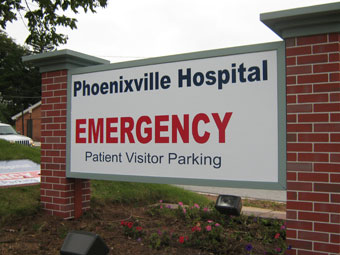 Ashley Bray
Ashley Bray
It was a change of pace for Phoenixville Hospital recently, as it wasn’t a patient that needed patching up—it was the signage. In order to stay current in today’s competitive environment, this Pennsylvania hospital was in need of a fresh, updated appearance.
Elmark Graphics was up for the challenge when the hospital’s marketing department brought them in on the project. The sign shop is located in West Chester, Pennsylvania and produces interior and exterior signs using materials such as MDO, vinyl, acrylic, and much more. Although the shop is twenty-eight years old, it went through some changes of its own three-and-a-half years ago when Owner and President Marjorie Wentz purchased it.
A few months after buying the company, Wentz obtained her Women’s Business Enterprise Certification. With this certification, the woman-owned shop was able to build its contacts, attract clients looking for tax benefits, and take advantage of the opportunities offered to its employees, such as meet-and-greets and educational sessions.
Weighing Options
When Elmark Graphics joined the project, Phoenixville Hospital wanted to replace its signs, but it didn’t have the budget for it. “Instead of replacing them, we opted to find a way to give them a fresh look,” says Wentz. “We came up with this idea of putting the brick pillars on either side of the legs.”
Elmark brought in Peachtree City Foamcraft to fabricate the pillars. The monument company had refurbished and updated signs before. “We can’t make a cheaper product. What we can do is offer alternatives, and this is one way to do it,” says Michael Fetter, sales manager at Peachtree. “Especially with the economy, people are trying to refresh their look. So the best way for us to do it is make accents and details that will freshen up a sign to make it look like a brand new sign.”
 Patching Up
Patching Up
Peachtree constructed the pillars out of foamcore encapsulated in plastic polymer and finished it to Elmark’s specifications. Peachtree created ten pillars for five signs, and each one had to meet different requirements because of issues such as sloping ground. The pillars were fabricated in a C-shape so that they could be slid onto the aluminum posts and bolted into place.
Creating ten different sized pillars can be viewed as a bit of a challenge, but Peachtree created standards so that the look remained the same across the pieces. The company retains all the samples it makes, so that on future projects, it’s easy to duplicate the appearance or create a similar design.
“We already have the process determined for certain looks, so we can match a lot of things,” says Fetter. “We pretty much have such a diverse library that we just pull up what we have, send customers the pictures, and if they say ‘yes,’ replicate the sample we have in-house and get it out to them quickly.”
Peachtree also fabricated caps for the pillars, and the company had to be aware of the overhang when making them, so that there was still room to go back into the sign panel. The caps and pillars took about three to four weeks to create. “We enjoy working with customers who always come to us with challenges that allow us to expand what we normally do,” says Fetter.
Finishing Touches
An inside, lower portion of the aluminum posts was still visible with the pillars on, so before the legs were placed on the new sign, Elmark painted the aluminum posts brick red to match the brick façade.
Before installing the pillars, Elmark replaced the white acrylic faces with new ivory acrylic ones. The shop digitally printed vinyl to specially match the unique color of the hospital’s logo, and then cut out the letters for the sign face with a plotter. Elmark also replaced the fluorescent bulbs inside the sign faces. Overall, the install took about two days.
In addition to the five refurbished signs, Elmark and Peachtree updated a changeable message board and a low-lying monument sign. Peachtree also fabricated one completely new sign for the hospital, which points out emergency exits. Still even the updated signs looked so different that passers-by thought the hospital had bought all-new signs.
 Elmark, together with Peachtree, succeeded in providing Phoenixville Hospital with a fresh look while keeping costs down. “It was probably 1/4 to 1/5 of the amount of money that they would have had to spend if they were going to just redo everything,” says Wentz. “So the savings were dramatic.”
Elmark, together with Peachtree, succeeded in providing Phoenixville Hospital with a fresh look while keeping costs down. “It was probably 1/4 to 1/5 of the amount of money that they would have had to spend if they were going to just redo everything,” says Wentz. “So the savings were dramatic.”
Wentz thinks refurbished signs have become more attractive to businesses. “I believe that this economy has changed buyer behavior,” she says. “People are more hesitant to buy, and updating signage is a safer, more cost-effective option.”
Peachtree has also done more business with refurbished signs in today’s market. “We try to meet the needs of our customers when they call,” says Fetter. “But if the customer can’t afford it, [we ask] what’s a good step back? And that’s when I [look at] what’s there. What we can do is use the existing sign, the box.”
Peachtree then adds new elements to the sign for an updated look. “Really all we’re doing is giving them a base or a decorative piece to put their panel back on—or to incorporate with—to make this all-new identification,” says Fetter.
Refurbished signage is also a way that sign shops and their clients can contribute to the green effort. “Why not just reuse what’s already there?” says Wentz. “We scrapped very little [for this project].”











